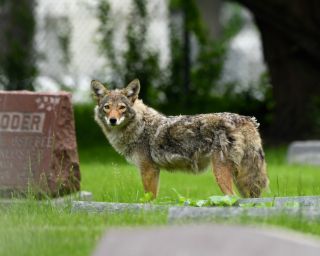Animal Behavior
Learning to Live With the Coyotes Next Door
The adaptable and intelligent coyote is finding success in urban areas.
Posted February 27, 2024 Reviewed by Abigail Fagan
Key points
- Coyotes are the largest animals to regularly live wild within cities in the U.S.
- Research suggests that coyotes are successful at utilizing the urban landscape while avoiding humans.
- Coyotes and humans can coexist, and both thrive, in urban environments.

The coyote is a survivor. Persecuted and hunted for generations, today they can be found in 49 states, ranging from lower Canada through parts of Central America. In recent decades, coyotes have even begun to move into cities, inciting fear and consternation among their human neighbors.
Stanley Gehrt, a wildlife ecologist at Ohio State University, initiated the Urban Coyote Research Project in Cook County, Illinois, more than 20 years ago to learn more about these misunderstood predators. Over the last 23 years, he and his colleagues have captured and tracked more than 1,450 coyotes in the Chicago area.
In his new book, Coyotes Among Us, written with Kerry Luft, Gehrt draws from his decades of experience to dispel pervasive coyote myths and make the case for why humans should embrace living near coyotes.
“Since 2000, we’ve been studying coyotes and their incredible ability to adapt and thrive as the top predator in urban environments,” Gehrt said in a press release. “Coyotes are here to stay—and the first step in learning to coexist is for us to better understand them.”

I talked with Gehrt about what his research has revealed about urban coyotes and what people should know about these wild neighbors.
Q: What is your background and how did you first become interested in coyotes?
Gehrt: My training is in wildlife management, and I've worked on a variety of different wildlife projects. I hoped I’d be able to study coyotes at some point, but it didn’t look like it would be in the cards for me because after my Ph.D., I ended up in Chicago working on urban wildlife. At that time, there were no coyotes, or at least very few coyotes, around Chicago or other cities.
Q: How did the Urban Coyote Research Project start?
Gehrt: I was doing research for Cook County Animal Control on raccoons and other, more traditionally urban animals. Then in 2000, they started getting reports of coyotes in areas where they had never been observed before, especially around neighborhoods. There was a lot of concern about that. Originally, the response was to remove a coyote each time someone reported it, but the numbers started to increase. They asked me to do some investigation to see what was going on with these animals. We started with the modest objective of doing a one-year study and hopefully putting radio collars on a few coyotes to understand their movement patterns and behavior.
Right away, I realized that I was wrong about a lot of things, especially in terms of how many coyotes are out there. We thought there would be very few, but it turns out there are a lot. We thought they would not be living very close to people or if they were, it would only be temporary; instead, it was a full population with residents and pups.
This increased interest in the project and the need for more information. Now that we’ve established that there is an actual, thriving coyote population, other questions have emerged. Throughout the project, we have been focused on the relationship between coyotes and people. Currently, we are interested in whether that relationship has changed over time as more and more generations of coyotes have been born and raised near people.
Q: What methods do you use to study the coyotes?
Gehrt: It depends on the question. To learn about space use and where coyotes go, especially with respect to people, we use radio telemetry. We capture and radio collar individuals and track them as best we can, learning how they're moving through the Chicago landscape. Diet is also a very important part of the project, because what coyotes eat determines their behavior. We use a technique called stable isotopes where we collect a whisker from each animal that we capture and analyze it to determine the animal’s diet during the time of that whisker’s growth. In addition, we use genetic analyses to look at their social relationships, as well as how certain diseases they carry may be influenced by their genes.

Q: What are some of the project’s major findings, especially pertaining to people coexisting with coyotes?
Gehrt: The most important thing for people to keep in mind is something that we discovered right away. The very first night I radio-tracked a coyote, I was stunned at how close she was to people. She was active at night, near people walking their dogs and close to people’s houses. She was just really good at hiding from people, so they didn't know she was there. We saw that the first night and it's been typical of the animals that we have followed since then. The general rule here is that no matter where you are in the urban landscape, coyotes are potentially your neighbors. It’s important to keep that in mind so you don’t do certain things that might contribute to conflict, such as unintentionally feeding them.
That leads to the other important thing for people to know: We have found that the vast majority of coyotes do not come into conflict with people. They actually go out of their way to avoid people, but the few coyotes that have come into conflict with people generally do so because of food. So it's really important to restrict their access to foods that are associated with people.
Q: What allows coyotes to be so successful in urban areas?
Gehrt: In terms of their population, they have an abundance of food available, a combination of natural as well as human food if they need to use it. Urban coyotes tend to be in great shape and they're not stressed because of a lack of resources. The other factor is high survival—their survival rate is higher in the city than it is out in the country, at least in the Midwest. That’s because there's very limited hunting or trapping taking place in the city and those are the biggest causes of mortality in the rural environment. The city is actually acting as a type of refuge for coyotes in a lot of ways.

Q: What questions are you currently studying?
Gehrt: We're interested in coyotes’ relationships with other wildlife, and we are currently finishing up our work on their role in white-tailed deer population dynamics. We think that through their predation of fawns, coyotes may help limit white-tailed deer population growth, which is a good thing for us, because deer are a big threat to people in Midwestern cities through auto collisions. And of course, there are ecological factors as well when you have overabundant deer. So we think that coyotes may be operating as a helpful aid in terms of deer management. There is also other prey. For instance, we know that rodents make up a large part of their diet, but we still have to learn more about what kind of role coyotes may have in terms of rodent dynamics in the city. We are also looking at personalities of coyotes and whether the city is selecting for a certain type of coyote with a certain kind of behavior that's genetically based. In other words, are we creating slightly different coyotes living in cities as opposed to rural areas?
Q: What do you find most rewarding or exciting about this research?
Gehrt: I love studying an animal that consistently teaches me lessons and consistently humbles me. The coyote is definitely that kind of animal. There are many mysteries about them and they're challenging to study. But I've just been fascinated with the fact that all our conventional ideas about how they work and how they function have usually been wrong. I find that to be amazing.
For many midwestern or eastern cities, the phenomenon of the urban coyote has only been taking place over the last 20 years or so. Now there are coyotes across most of the U.S. and Canada. It is kind of a large, unplanned experiment that was basically started by coyotes and we're just along for the ride, trying to understand how this experiment is going to continue and turn out.
References
Gehrt SD and Luft K. 2024. Coyotes Among Us: Secrets of the City’s Top Predator. Flashpoint Books, Seattle.




